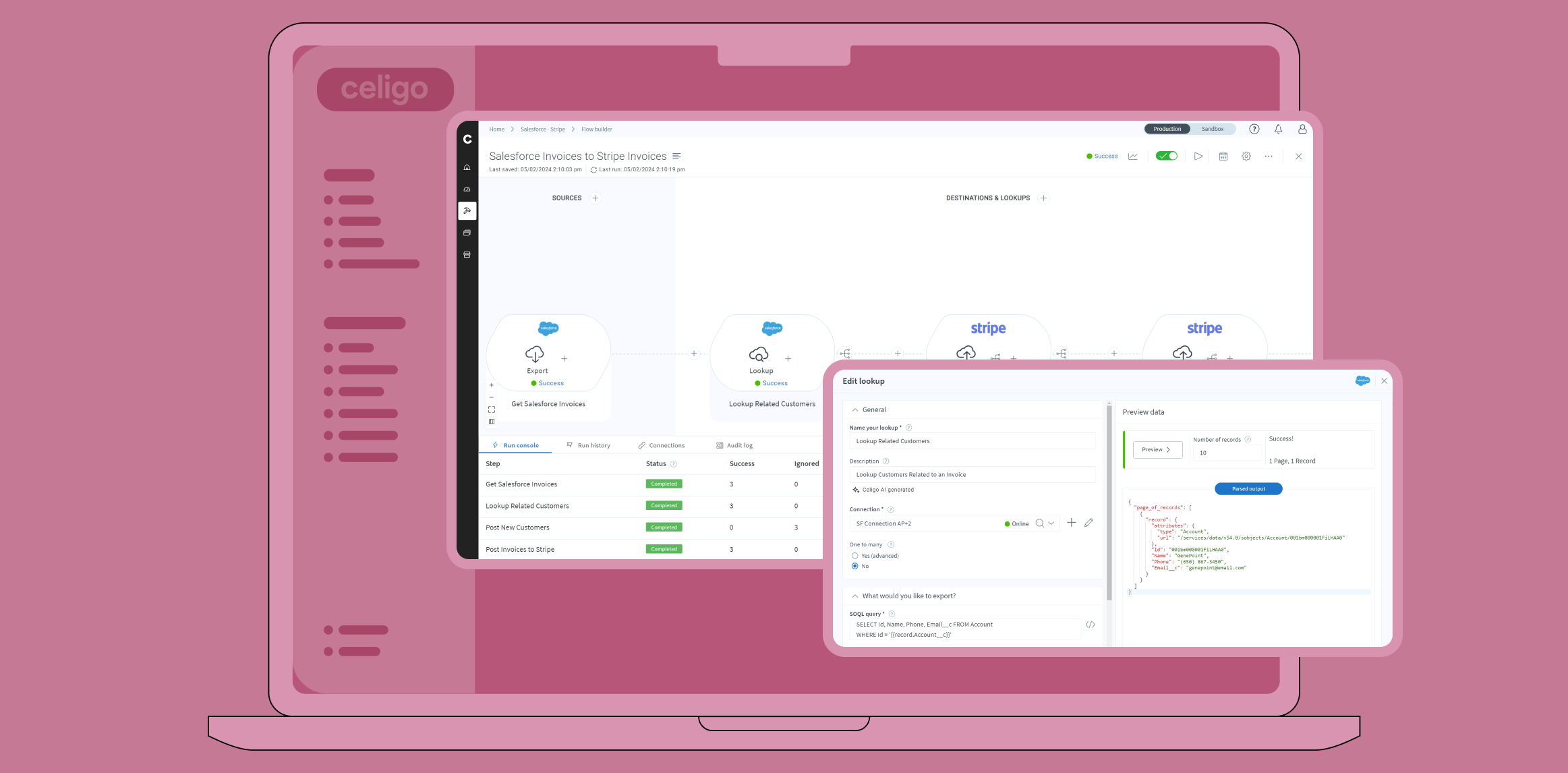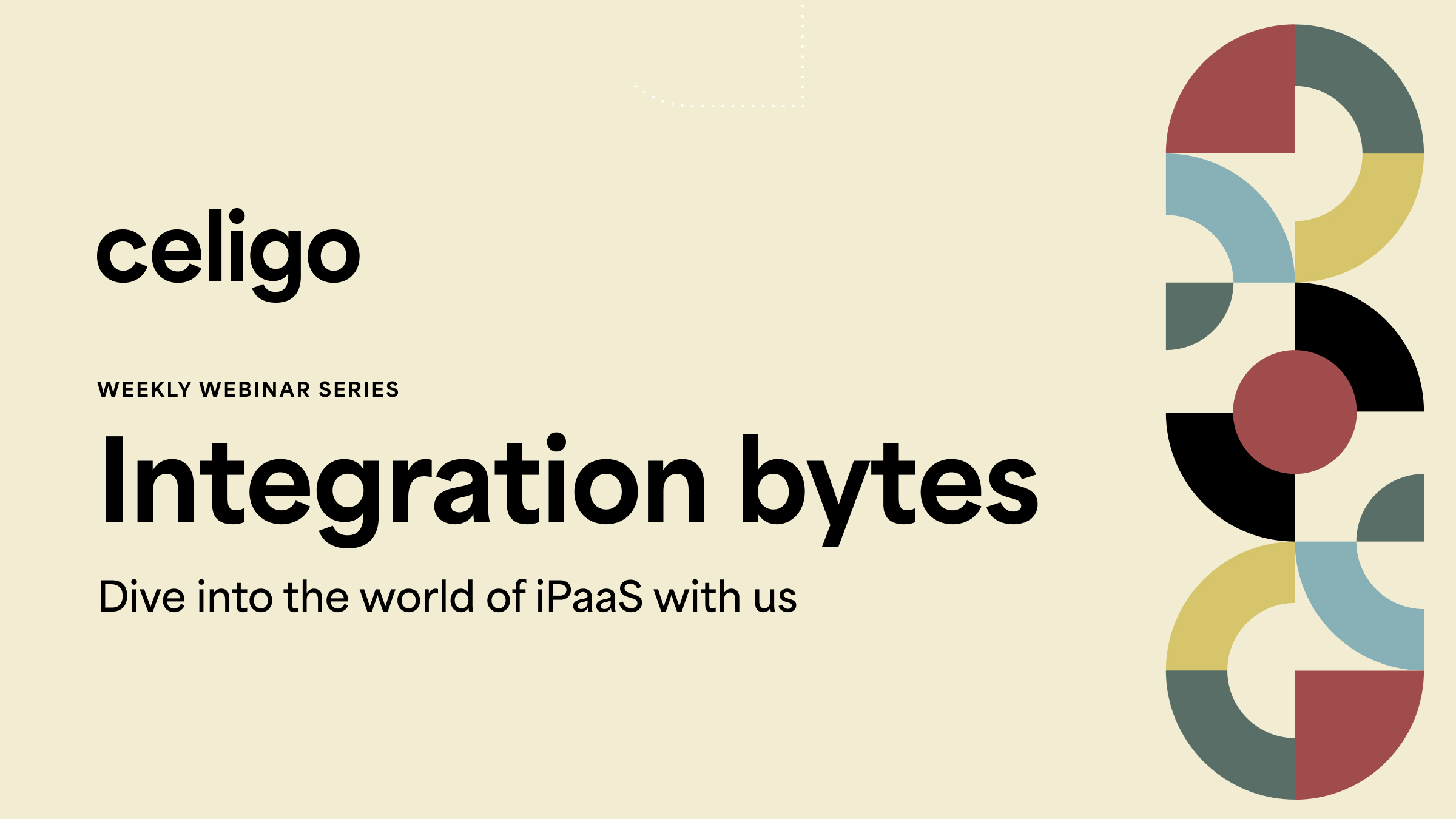Published May 31, 2024
How to integrate APIs

The name of the game these days is automation—and apps are no exception. Most businesses need to automatically send notifications to customers, sync data between their sales and marketing platforms, or pull the latest financial data from external sources. Manually handling these tasks can be time-consuming and error-prone. This is where API integration comes in.
API integration has become a key aspect of seamless software connectivity. As businesses strive to stay competitive, the ability to integrate various applications smoothly is more crucial than ever. Celigo plays a pivotal role in this arena, simplifying complex integration challenges so that businesses can focus on growth and innovation.
What’s an API?
Application Programming Interface is a set of protocols that allow one software application to interact with another. Think of an API as a waiter in a restaurant. Just as a waiter takes your order, gets it to the kitchen, and then delivers your meal back to you, an API works similarly. It takes a request from one application, communicates it to another application, and then returns the response.
For instance, when you use a travel booking site, the site interacts with various airlines’ APIs to show you flight options. This interaction is made possible by APIs working behind the scenes, allowing different systems to communicate without a hitch.
By understanding API basics, we can appreciate their role in connecting diverse software systems and streamlining operations within our digital environment. This also reveals just how important integration is.
Understanding API integration
API integration connects different software systems through their APIs so that they can share data without interruption. Without it, businesses can’t automate workflows—but with integration, that data flows effortlessly between applications.
API integrations work by using the endpoints provided by each software system to send and receive data. When one application sends a request to another through an API, the receiving application processes the request and sends back the appropriate response. This can all happen with real-time updates, so businesses get accurate requests and information nearly instantaneously.
For example, when a customer places an order on an e-commerce site, the site’s API can communicate with the payment gateway’s API to process the payment. It also communicates with the inventory system’s API to update stock levels. This ensures all systems are updated in real time, reducing the need for manual intervention and minimizing errors.
The more digital things become, the more important and strategic API integration is. Some of the most impactful ways that API integration affects businesses include:
- Boosted productivity and efficiency: By automating data exchange between different software applications, businesses can significantly reduce manual data entry, saving time and resources. This helps employees focus on more strategic tasks rather than repetitive administrative work.
- Easy coordination between applications: API integration also ensures that various software systems used within a business can work together without issues. This level of communication is ideal for creating cohesive workflows so that data is consistent and accurate across all platforms.
- Better customer experience: When businesses use APIs to integrate customer-facing applications, they can provide a more responsive user experience. For instance, integrating a CRM system with a marketing automation platform allows for personalized marketing campaigns based on real-time customer data.
- Scalability and flexibility: As businesses grow, their software needs evolve. API integration provides the flexibility to connect new applications and scale existing ones without disrupting operations. This adaptability helps organizations keep up with changing business requirements and market dynamics.
- Data-driven decision-making: By integrating various data sources, businesses can gain insights into their operations. APIs make aggregation of data from different applications possible—so your leadership can make data-driven decisions.
By leveraging the capabilities of APIs, businesses unlock new opportunities for growth and innovation. Now, we need to cover how to integrate APIs—which is next on the docket.
How to integrate APIs
Integrating APIs can be approached in different ways, each with its own set of challenges and benefits. Two primary methods are manual API integration and using an Integration Platform as a Service (iPaaS). Understanding these methods helps businesses choose the best approach for their needs.
Manual API integration
First, let’s take a closer look at manual integration. This method directly connects software applications using their respective APIs without third-party integration platforms. It requires a thorough understanding of the APIs being used and a pretty hefty investment in time and resources. Here’s a closer look at the process:
1. Determine business needs
The first step is to identify the specific business needs that the integration aims to address. This could be automating data entry, syncing information across different platforms, or making customer experiences better. Clearly defining the objectives helps in planning the integration process and getting everyone on the right page.
2. Assess workflow improvements
It’s also important to evaluate how API integration can streamline workflows. For instance, integrating a CRM system with an email marketing platform can automate the process of updating customer information and segmenting email lists. Understanding the potential workflow improvements helps justify the integration efforts and set measurable goals.
3. Assemble a skilled team
Successful manual API integration needs a dedicated team of IT and development professionals who are proficient in coding and familiar with the APIs of the platforms being integrated. This team is responsible for writing the code, setting up the integration, and ensuring that it functions as intended.
4. Conduct ongoing testing and validation
Once the initial integration setup is complete, testing is just as important to make sure that the APIs communicate correctly so that data is accurately exchanged. Ongoing testing and validation help identify and resolve issues early on, which prevents disruptions in your business operations.
5. Maintain and update integrations
Even after testing, API integrations are not a one-time setup. They require continuous maintenance and updates to adapt to changes in the platforms, address security vulnerabilities, and add new features. It’s wise to have an established team for this purpose so that your integration is both reliable and long-lasting.
6. Consider the costs
Organizations are always examining their budget, so keep in mind that manual API integration can be costly. This is due to the need for skilled personnel and ongoing maintenance. While this method offers high customization and control, businesses must weigh these benefits against the necessary investments.
So, what do organizations really need to consider with manual API integration? While resource-intensive, this option provides businesses with the flexibility to tailor integrations to their specific needs. However, for many companies, leveraging an Integration Platform as a Service can be a more efficient and cost-effective alternative.
API integration with an iPaaS
An Integration Platform as a Service, or iPaaS, offers an especially streamlined approach to API integration. These platforms provide pre-built connectors and tools that simplify the integration process—which allows businesses to connect different applications with minimal coding.
In other words, iPaaS platforms serve as middleware, giving various software applications a centralized interface. They offer a range of tools and features designed to automate and manage integrations, cutting back on complexity compared to manual methods.
Here’s a closer look at how iPaaS works with API integration:
Keeping things simple
As mentioned, iPaaS platforms typically provide pre-built connectors for popular applications, allowing businesses to set up integrations quickly. These connectors handle the communication between APIs, so you really don’t have to worry about custom coding. For instance, Celigo’s iPaaS solution includes connectors for a wide range of applications, from CRM systems to e-commerce platforms.
Automating tasks
One of the key advantages of using an iPaaS is the ability to automate routine tasks. For example, data synchronization between a CRM and an accounting system can be automated, ensuring that records are updated in real time without manual intervention. This automation reduces the risk of errors and frees up staff to focus on more strategic activities.
User-friendly integration tools
Many iPaaS platforms offer low-code or no-code interfaces, which helps business users with limited technical expertise set up and manage integrations. This allows businesses to be more agile and depend less on specialized IT personnel.
Growth and flexibility
iPaaS solutions are also designed to scale with business growth. Businesses can easily add new applications and adjust existing integrations as needed. This scalability ensures that the integration infrastructure can evolve alongside the business as they plan for long-term success.
Cost-effectiveness
Using an iPaaS can be more cost-effective than manual integration. The initial setup is quicker, and ongoing maintenance is typically handled by the platform provider. This way, you don’t need a dedicated in-house team, which lowers overall costs and lets you allocate resources more strategically.
The right iPaas platform simplifies API integration through an intuitive interface, pre-built connectors, and extensive automation capabilities. With this tool, businesses can integrate various applications with minimal effort so that data flows easily for their operations.
Take the next steps with Celigo
Automating data exchanges and improving application communication is a key benefit that businesses need. API integration can transform how businesses operate. However, the process can be complex and resource-intensive when done manually.
Celigo simplifies this process with its iPaaS. With user-friendly tools and pre-built connectors, Celigo makes API integration accessible for all kinds of organizations. Businesses can quickly set up and manage integrations without extensive coding or specialized IT resources. Best of all, as your business grows, Celigo’s platform ensures that your integration infrastructure evolves with you.
Don’t let integration challenges hinder your business success. Dive into Celigo’s expertise and innovative solutions to harness the full potential of API integration. Contact us today to learn more about how Celigo can help your business achieve its goals!




